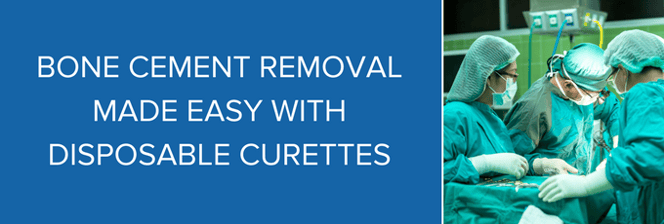
Prior to the development of single use disposable bone cement removal curettes, orthopedic surgeons’ most common options for removing excess soft cement during primary TJR were using a metal tool that was close at hand…a freer, a metal bone curette or other instrument made of steel...or even a gloved finger. With a metal tool, there is increased chance of scratching the prosthesis, possibly resulting in long-term complications. With the cement covered gloved finger a time-consuming re-gloving is required.
A common and expensive repercussion of using metal tools to remove excess cement is that the cement dries on the tool. That means valuable, expensive staff and operating room time must be devoted to scraping the tools prior to re-sterilization. And, it is not uncommon for the tool to retain dried cement even after cleaning and re-sterilizing, causing delay during the next surgery as an alternative sterile tool is retrieved.
Using Disposable Curettes to Remove Cement Without Scratching
Today there is an easier and safer way to remove bone cement: No-Scratch™ Whitney Curette™. These tools make the application, manipulation, and removal of bone cement far simpler than it used to be through the use of innovative design and top-quality materials.
Here are some specific benefits that you’ll see when you use these disposable curettes.
Safer Materials Than Steel
Each curette is made of durable plastic that offers plenty of sturdiness while remaining softer than surgical steel. You won’t need to worry about causing damage to the surface of the prosthesis when removing bone cement with them.
Easier Manipulation
Disposable curettes are designed with molded-in thumb indentations for instant orientation. They’re also easier to maneuver in spaces with minimal visibility. Each tool is color-coded to allow for easy identification when needed.
Efficient Design
These sterile tools come individually packaged in peel pouches that easily accommodate aseptic technique. They are packaged in cartons of 25 per carton, for easy storage. They also offer peak precision, whether applying, manipulating, or removing cement. Their disposability helps eliminate the time needed to remove hardened cement or re-sterilize each tool.
Lower Costs
Compared to steel curettes, they are also less expensive to purchase. And, being disposable, there is no need to accrue the additional costs incurred when cleaning, re-sterilizing and adding back into inventory.
With these curettes being constructed with a single tip, unlike other disposable options with tips at either end, you only pay for what you need. No reason to purchase a disposable tool, for more money, with a tip you never use.
With these benefits associated with these no-scratch plastic curettes, bone cement removal can ultimately be safer and more efficient while helping reduce expenses, a very useful innovation in hip and knee replacement surgery.

